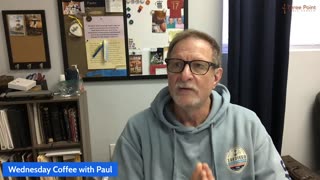Premium Only Content

Mark 6:14-56 The Shadow of John's Death and the Light of Jesus' Miracles
Overview Mark 6:14-56 is a pivotal section in the Gospel of Mark, blending themes of power, tragedy, compassion, and divine authority. It contrasts human frailty and fear with Jesus' miraculous sovereignty, advancing the narrative toward his identity as the Messiah. The passage can be divided into key episodes, highlighting Herod's court intrigue, Jesus' ministry amid growing crowds, and a series of miracles that reveal his power over nature, provision, and illness. Key Events Herod's Fear and John's Execution (vv. 14-29)
King Herod Antipas hears rumors about Jesus' ministry and superstitiously believes he is John the Baptist resurrected from the dead. This triggers a flashback to John's imprisonment: Herod had arrested John for criticizing his unlawful marriage to Herodias (his brother Philip's wife). During a lavish birthday banquet, Herodias' daughter (traditionally identified as Salome) dances for Herod, who promises her anything in return. Prompted by her mother, she requests John's head on a platter. Reluctantly, Herod complies to save face before his guests, and John is beheaded in prison. His disciples bury the body. This grim tale underscores the peril faced by prophets who confront corrupt authority, foreshadowing Jesus' own fate.
The Apostles' Return and Feeding the Five Thousand (vv. 30-44)
The apostles return from their mission (sent out in vv. 7-13) and report to Jesus, but the press of crowds prevents rest. Jesus, moved with compassion, sees the people as "sheep without a shepherd" and teaches them at length. As evening falls near a remote area, the disciples urge Jesus to send the crowd away for food. Instead, Jesus challenges them to feed the 5,000 men (plus women and children) with just five loaves and two fish. He blesses and breaks the bread, and miraculously, all eat and are satisfied, with twelve baskets of leftovers collected. This is the only miracle recorded in all four Gospels, symbolizing Jesus as the provider like manna in the wilderness and pointing to the Eucharist.
Jesus Walks on Water (vv. 45-52)
Jesus sends the disciples ahead by boat across the Sea of Galilee to Bethsaida while he prays alone on a mountainside. A storm arises, and the disciples struggle to row against fierce winds. In the fourth watch of the night (around 3-6 a.m.), Jesus approaches walking on the water, intending to pass by them. Terrified, they cry out, thinking he's a ghost. Jesus reassures them: "Take courage! It is I. Don’t be afraid" (v. 50). He climbs into the boat, the wind dies instantly, and the disciples are awestruck, their hearts hardened by the earlier miracle—they hadn't understood its significance. This episode echoes Old Testament theophanies (e.g., God walking on the sea in Job 9:8) and reveals Jesus' divine identity ("I am," echoing Exodus 3:14).
Healings in Gennesaret (vv. 53-56)
The boat lands at Gennesaret, where word of Jesus spreads quickly. People flock from surrounding areas, carrying the sick on mats to wherever he goes. They beg to touch even the fringe of his cloak, and all who do are healed. This rapid, faith-driven healing frenzy emphasizes Jesus' growing fame and the power inherent in his presence, evoking Isaiah 53's suffering servant who bears others' infirmities.
Themes and Significance Power and Authority: Herod's earthly power leads to murder, but Jesus' authority brings life—through teaching, provision, and healing—without coercion.
Compassion Amid Chaos: Jesus responds to human need with empathy, even when exhausted, modeling divine mercy.
Disciples' Hardened Hearts: The apostles witness miracles yet remain fearful and uncomprehending, highlighting the slow journey of faith.
Foreshadowing: John's death prefigures Jesus' passion, while the miracles affirm his messianic role, building tension toward the cross.
This passage pulses with urgency, characteristic of Mark's fast-paced style, inviting readers to recognize Jesus not as a revived prophet but as the incarnate God who calms storms and feeds multitudes.
-
 10:17
10:17
Three Point Bible Church
18 days agoWednesday Coffee with Paul
61 -
 2:38:16
2:38:16
I_Came_With_Fire_Podcast
13 hours agoDid Pete Hegseth Commit WAR CRIMES | No more INCOME TAX | More Fraud in Minnesota W/ Mike Caldarisie
28.5K11 -
 1:32:30
1:32:30
Adam Does Movies
8 hours ago $1.25 earnedTalking Movies + Ask Me Anything - LIVE
21.8K1 -
 2:12:14
2:12:14
TheSaltyCracker
6 hours agoWar Crimes ReeEEStream 12-03-25
77.7K180 -
 1:31:59
1:31:59
Glenn Greenwald
7 hours agoTrump Administration Claims to Save Hundreds of Millions of Lives by Blowing Up Drug Boats; Ethan Klein's Unhinged Vengeance & Lawsuits Against Other YouTubers: With Taylor Lorenz | SYSTEM UPDATE #553
107K148 -
 19:14
19:14
MetatronCore
23 hours agoHow Propaganda works on your Brain
18.3K6 -
 1:26:32
1:26:32
Joker Effect
4 hours agoWHO IS TYSON HOCKLEY?! What does the IRL streaming space look like? WHY IS EVERYONE SUEING EACHOTHER
8.65K -
 2:48:40
2:48:40
Barry Cunningham
8 hours agoLIVE BREAKING NEWS: Erika Kirk and TPUSA Have Had It With Candace Owens | Where Are The Children?
56.7K72 -
 15:30
15:30
IsaacButterfield
21 hours ago $1.21 earnedViolent Immigrant Crime Is Exploding in Australia
13.6K17 -
 8:37
8:37
DBoss_Firearms
12 hours ago $0.47 earnedHow hard is it to shoot with a G-Flex Trigger?
9.32K